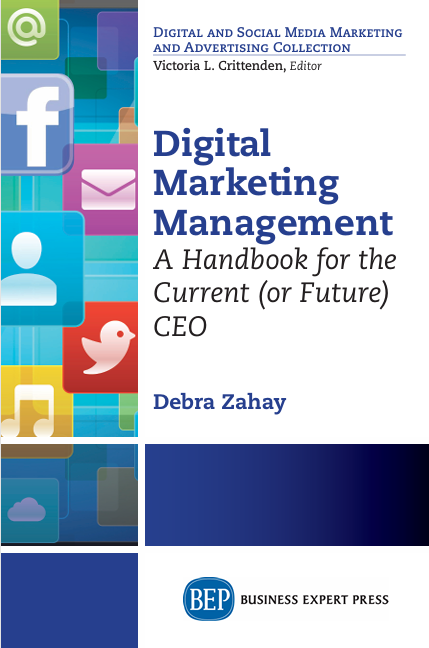
Digital Marketing Management
Author: Debra Zahay Category: Manajemen Publisher: Business Expert Press ISBN: 978-1-60649-925-2When I began my career as a marketing professional, e-mail was a
rare privilege. There were four major forms of marketing communica
tion: in-person, phone, fax, and postal mail. Everything that we needed
to know about the customer we learned from talking to the customer,
research surveys or from transaction records, laboriously collected, and
sometimes painstakingly supplemented. There was no online behavioral
data to analyze, no web logs, or click-through rates.
I remember, not too long ago, going through hard copies of print
outs with a yellow highlighter to pick out the industries which were most
likely to yield increased sales in terms of vertical marketing specializa
tion (a technique which worked, by the way). I was somewhat unique in
having come from an information systems background in being able to
coax decisions from data in the organization. Those who knew how to do
so usually labored, as I did, in direct marketing, one of the few areas of
marketing which relied on customer data analysis for decision making.
Now I would argue that the individual who is in marketing cannot
escape the inexorable rise of technology and its applications. A prolif
eration of communications channels and a reliance upon technology
by both business-to-business (B2B) and business-to-consumer markets
(B2C) means that we marketers are dependent upon the importance of
digital marketing. Not only that, digital marketing is the responsibility
of everyone in the organization, beginning with upper management. For
example, if 93 percent of purchases begin with searching the web, then
search is everybody’s business in the company, not just that of marketing.1
T
his book is a handbook for the management of digital marketing.
It is not, like my other book, Internet Marketing: Integrating Online and
Offline Strategies, with MaryLou Roberts, designed to also be used in a
skills-based course and provide a detailed overview of the ins and outs of
1
Sticky Branding. “93% of B2B Purchases Start With Search,” https://www.sticky
branding.com/93-of-b2b-purchases-start-with-search/ (10/13/2014).
xvi
INTRODUCTION
digital marketing. Those seeking to learn the details of operating social
media platforms or how to effectively create paid search ads can look to
that text or other resources to do so.
T
his book is for managers, students of management, or would-be
managers and those who are just seeking knowledge of the subject who
need to know not how to do things on digital marketing tools but why to
do things. The intent of this book is to teach managers how to reframe
and rethink their organizations so that digital marketing is integral to
their operations. A recent study from the Online Marketing Institute said
that only eight percent of brands think that their team is up to speed in
digital marketing and strong across all channels.2 In my classes, I sup
plement this material with practical, hands-on applications, such as the
Google Online Marketing Challenge (GOMC) or the Stukent Internet
Marketing Simulation.
T
his book will also help pinpoint the people skills necessary to build
the digital marketing organization and also help identify and classify the
important elements of digital marketing in the organization. Although
there are some leading-edge programs in this area, marketing academics
have been slow to make the transition to digital marketing and some aca
demic programs lack practical knowledge. It highly likely that skills and
specializations will have to be developed in-house as well as hired from
without, because of the shortage of those with knowledge in this field.
Managers need to know what skills to develop in their employees, not
necessarily to have the skills themselves.
To summarize, the book’s target is anyone who needs to understand
how to incorporate digital marketing into their organization at a strategic
level. It is hoped the book will be as useful to the small business owner as
to the CMO of a large company. Many of those reading this book devel
oped and succeeded in their careers in an era without Facebook, Twitter,
e-mail, and paid search; many are “digital natives” but use the Internet
for their own education and enjoyment and not for marketing purposes.
2Gesenhues. 2013. “Study: Only 8% of Brand Believe Their Marketing Team is Strong
Across All Digital Marketing Channels.” Marketing Land. http://marketingland.
com/study-only-8-of-companies-believe-marketing-team-is-strong-across-all-areas
of-digital-marketing-64404 (11/13/2014).
INTRODUCTION xvii
T
he book can be read on its own or to upgrade your skills or as part of an
undergraduate or Master’s level course in the subject.
T
he book will focus on current technology usage but not the details,
which change on a daily, if not hourly basis. This book is meant, as the
title says, to be used as a guideline for the management of digital market
ing processes. I hope that at the end readers will have a better idea of why
these principles and ideas are important and how to implement them in
the organization. So let’s get started. . . .
Back